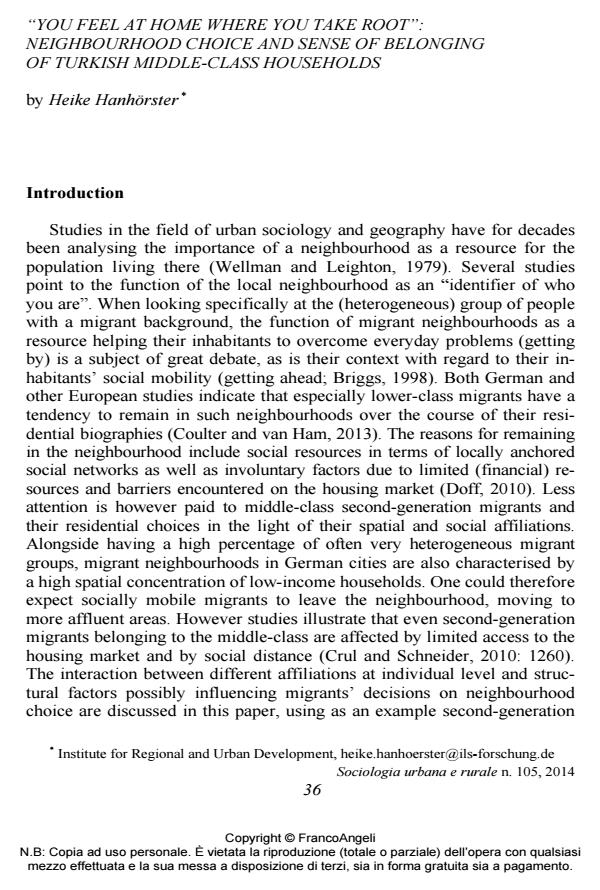"You Feel At Home Where You Take Root": Neighbourhood Choice And Sense Of Belonging Of Turkish Middle-Class Households
Journal title SOCIOLOGIA URBANA E RURALE
Author/s Heike Hanhörster
Publishing Year 2014 Issue 2014/105
Language English Pages 14 P. 36-49 File size 219 KB
DOI 10.3280/SUR2014-105003
DOI is like a bar code for intellectual property: to have more infomation
click here
Below, you can see the article first page
If you want to buy this article in PDF format, you can do it, following the instructions to buy download credits

FrancoAngeli is member of Publishers International Linking Association, Inc (PILA), a not-for-profit association which run the CrossRef service enabling links to and from online scholarly content.
Numerosi studi evidenziano l’importanza del vicinato locale come "fattore della propria identità". Nel presente contributo vengono discussi l’interazione tra diverse affiliazioni e il conseguente effetto sulle decisioni degli immigrati per quanto concerne la scelta del vicinato. Lo studio si concentra sulle scelte residenziali dei nuclei familiari del ceto medio turco in Germania, analizzando le loro scelte di compromesso tra appartenenza locale e posizionamento sociale in fase di acquisto della proprietà.
Keywords: Neighbourhood Choice, Belonging, Low-Income Neighbourhoods, Residential Relocation, Migrants, Affiliation
- Alba R. (2005): Bright vs. blurred boundaries: Second generation assimilation and exclusion in France, Germany, and the United States. Ethnic and Racial Studies, 28: 1: 20-49. DOI: 10.1080/014198704200028000
- Andreotti A., Le Galès P., Moreno Fuentes F.J. (2013). Controlling the Urban Fabric: The Complex Game of Distance and Proximity in European Upper-Middle-Class Residential Strategies. International Journal of Urban and Regional Research, 2: 576-597. DOI: 10.1111/j.1468-2427.2012.01177.
- Antidiskriminierungsstelle des Bundes (Federal Anti-Discrimination Agency) (ed.) (2009).
- Diskriminierung im Alltag. Abschlussbericht, Berlin.
- Bergström L., van Ham M., Manley D. (2010). Neighbourhood Choice and Neighbourhood Reproduction. In Institute for the Study of Labor (Eds.): Discussion Paper 5238, October
- 2010. Bourdieu P. (1991). Physischer, sozialer und angeeigneter physischer Raum. In Wentz, M. (Ed.). Stadt-Räume. Frankfurt am Main: New York.
- Briggs X., de S. (1998). Brown Kids in White Suburbs: Housing Mobility and the Multiple Faces of Social Capital. Housing Policy Debate, 1: 177-221. DOI: 10.1080/10511482.1998.952129
- Butler T., Robson G. (2001). Social Capital, Gentrification and Neighbourhood Change in London: A Comparison of Three South London Neighbourhoods. Urban Studies 12: 2145-2162. DOI: 10.1080/0042098012008709
- Coulter R., van Ham M. (2013). Following people through time: An analysis of individual residential mobility biographies. Housing Studies, 7: 1037-1055. DOI: 10.1080/02673037.2013.78390
- Crul M., Schneider J. (2010). Comparative integration context theory: participation and belonging
- in new diverse European cities. Ethnic and Racial Studies, 7: 1249-1268. DOI: 10.1080/0141987100362406
- Doff W. (2010). Puzzling neighbourhood effects: Spatial selection, ethnic concentration and neighbourhood impacts. Delft: IOS Press.
- Granovetter M.S. (1973). The strength of weak ties. American Journal of Sociology, 78: 1360-1380. DOI: 10.1086/22546
- Hanhörster H. (2000). Whose neighbourhood is it? Ethnic diversity in urban spaces in Germany. GeoJournal, 4: 329-338. DOI: 10.1023/A:101227301451
- Holm A. (2014). Die Wiederkehr der Wohnungsfrage. APuZ, 20-21.
- Horr A. (2008). Ethnische und soziale Unterschiede in der Wohnungssuche. In Hillmann, F.;
- Windzio, M. (ed.) Migration und städtischer Raum. Chancen und Risiken der Segregation und Integration. Opladen.
- Jenkins R. (2008). Social Identity. London, New York: Sage.
- Lacy K.R. (2004). Black spaces, black places: Strategic assimilation and identity construction in middle-class suburbia. Ethnic and Racial Studies, 6: 908-930. DOI: 10.1080/014198704200026852
- Münch S. (2009): “It’s all in the mix” - Constructing ethnic segregation as a social problem in Germany. Journal of Housing and the Built environment, 4: 441-455. DOI: 10.1007/s10901-009-9160-
- Noreisch K. (2007). School catchment area evasion: the case of Berlin, Germany. Journal of Education Policy, 1: 69-90. DOI: 10.1080/0268093060106575
- Savage M., Bagnall G., Longhurst B. (2005). Globalization and belonging. London: Sage. Sürig I., Wilmes M. (2011). Die Integration der zweiten Generation in Deutschland.
- Ergebnisse der TIES-Studie zur türkischen und jugoslawischen Einwanderung. IMISBeiträge, 93. DOI: 10.1007/s11578-005-0035-
- Sutterlüty F., Walter I. (2005). Übernahmegerüchte. Klassifikationskämpfe zwischen türkischen Aufsteigern und ihren deutschen Nachbarn. Leviathan 33: 182-204. DOI: 10.1177/004209801037139
- Wellman B., Leighton B. (1979). Networks, Neighborhoods, and Communities: Approaches to the Study of the Community Question. Urban Affairs Review, 14: 363-390. DOI: 10.1177/10780874790140030
- Watt P. (2009). Living in an oasis: Middle-class disaffiliation and selective belonging in an English suburb. Environment and Planning A, 12: 2874–2892. DOI: 10.1068/a4112
- Sykes B., Musterd S. (2011). Examining Neighbourhood and School Effects Simultaneously: What Does the Dutch Evidence Show? Urban Studies, 7: 1307-1331. DOI: 10.1177/004209801037139
Heike Hanhörster, "You Feel At Home Where You Take Root": Neighbourhood Choice And Sense Of Belonging Of Turkish Middle-Class Households in "SOCIOLOGIA URBANA E RURALE" 105/2014, pp 36-49, DOI: 10.3280/SUR2014-105003